
One of the most critical aspects of running a successful agency is knowing how to get SEO leads and converting them into clients.
The truth is, the SEO and marketing industry is competitive.
It doesn’t matter whether you’re based in the US, Canada, or even Singapore; chances are that you have tens of thousands of other digital agencies competing with you, and fighting for a slice of the same pie.
In fact, if you check the Clutch website, you’ll see that there are more than 100,000 digital marketing agencies listed.
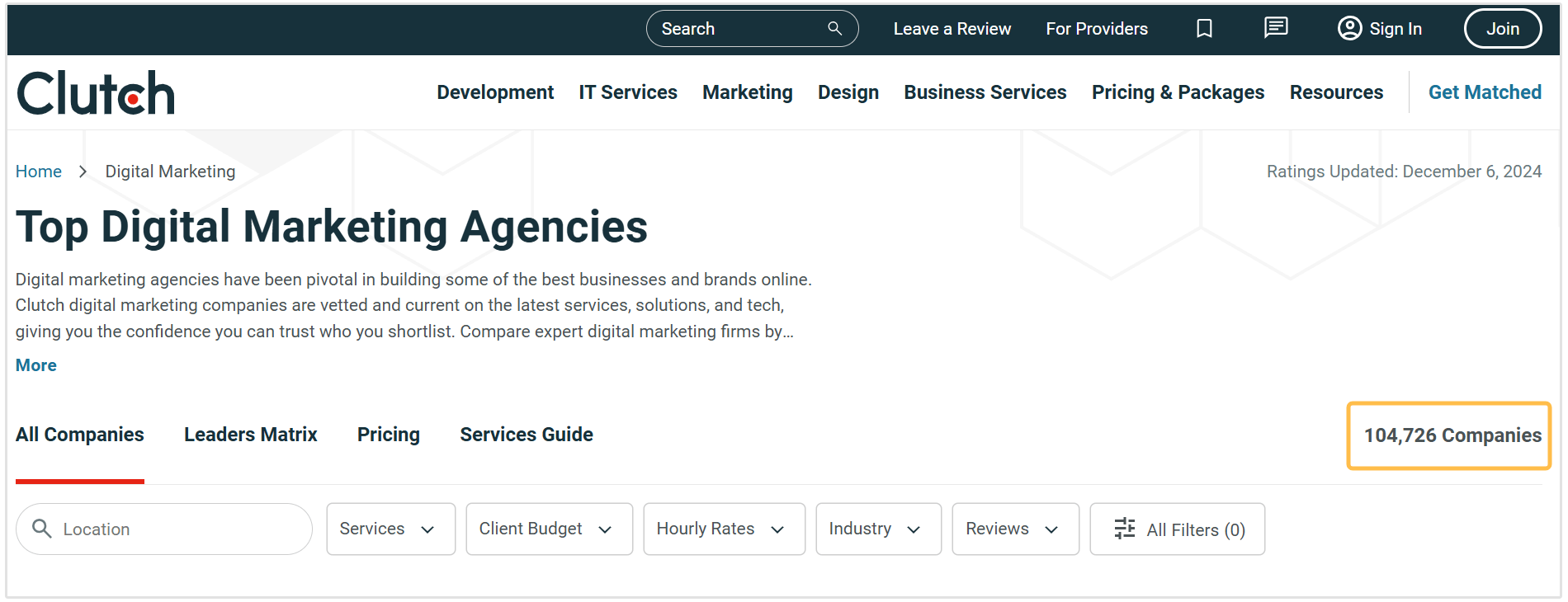
But don’t be dismayed. There are several tried-and-tested strategies that you can use to generate SEO leads for your agency.
If you want to learn to get SEO clients, you’re in the right place. In this guide, we’ll walk you through:
- How to find SEO leads and get more SEO clients
- How to qualify SEO leads before reaching out to them
- Best practices for getting in touch with prospects and what not to do with your SEO leads
- The best tools you can use to get SEO leads and clients
By the time you get to the end of our guide, you’ll have an arsenal of new ideas and tactics on SEO leads and how to get SEO clients.
Seeing as we deal with a lot of agencies on a daily basis, we thought it would be useful to talk to some agency founders about how they find leads and get more clients. You’ll find all of their insights and tips throughout this post.
With that being said, I’d like to thank the following people for their valuable feedback and contributions:
- Peter Heise, President of Correct Digital, Florida, United States
- Jesse Ringer, Founder and CEO at Method and Metric SEO Agency, British Columbia, Canada
- Anthony Barone, SEO Consultant, Co-founder and Managing Director of StudioHawk, London, United Kingdom
- Kyle Morris, CEO and Founder at LawTurbo, California, United States
- Grant Covault, Former Chief Business Development Officer at Marketing Essentials, Ohio, United States
- Andrew Clark, Former Director of Organic Growth Marketing, DAVID.MARKET, New York, United States
- Sam Browne, Founder at HARO SEO, Auckland, New Zealand
- Oun Art, Founder & Chief Link Strategist at LinkEmpire, Cambodia
- Filip Dimitrijevski, Business Development Manager at ClickVision BPO, Malmo, Sweden
- Paul DeMott, Chief Technology Officer at Helium SEO, Ohio, United States
- Nathaniel Miller, Founder at The SEO Marketing Dad, Missouri, United States
What are SEO Leads?
An SEO lead can be defined as someone or a business who has shown interest in your SEO services. They might be looking for help with link-building, technical SEO, local SEO, content marketing or any other SEO-related services.
Ideally you should have an “always on” lead generation system that brings in qualified SEO leads on a constant basis, this will ensure that you have a solid database of leads that you can convert into clients.
Let’s look at some of the best ways to generate SEO leads and get SEO clients for your agency.
Create and Optimize Service Pages
An SEO agency can use its website to generate SEO leads. This ties in nicely with creating blog content to attract targeted visitors, but this tactic deals more with optimizing service pages by using SEO best practices.
Let’s look at an example of this in action. If you search for “seo agency in montreal”, you’ll notice one of the results is from Thrive Internet Marketing Agency.

By clicking on their search result, you’ll be redirected to their “Montreal SEO Company” service page.
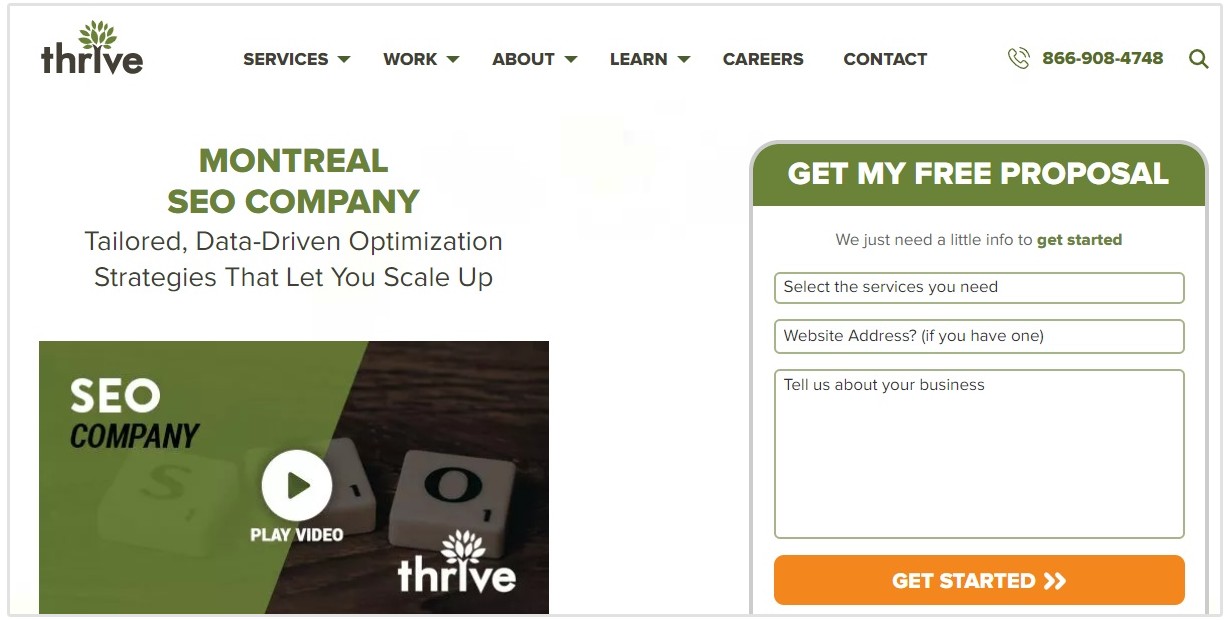
This page is heavily optimized to rank for relevant search terms and is a prime example of how to structure a location page for local SEO.
This web page is getting targeted, organic traffic, but it also features a form where visitors can submit their details to get access to a free SEO audit of their website.
Through this form, Thrive is able to convert that traffic into SEO leads through the use of this lead generation form.
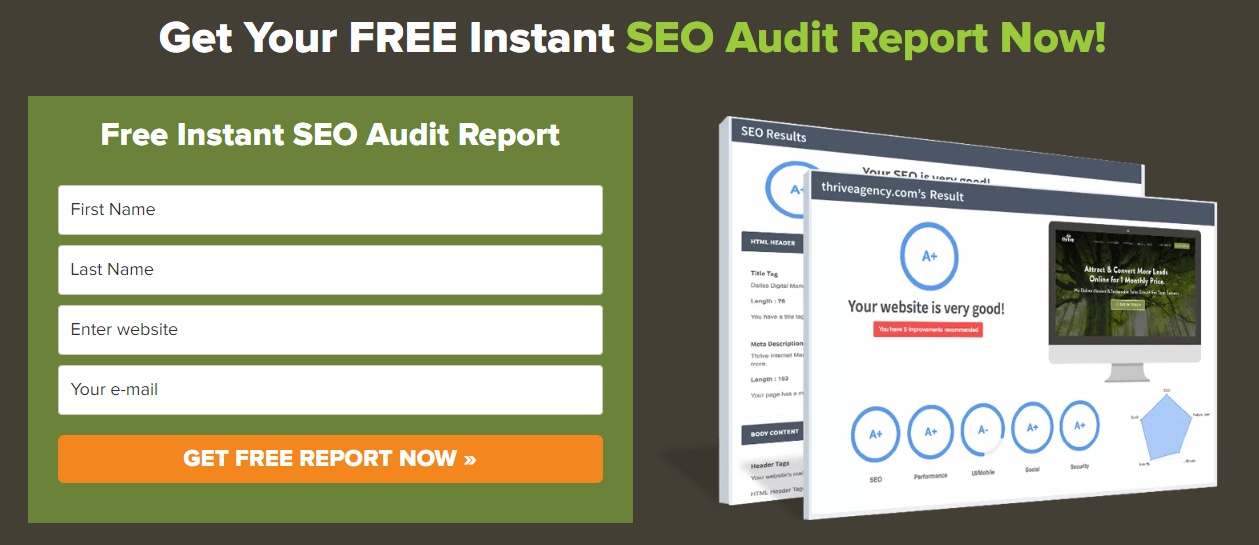
If you want to implement the same form on your website, SEOptimer is the perfect solution for you.
Our Embeddable Audit Tool is ideal for agencies that want to generate leads directly from their website.
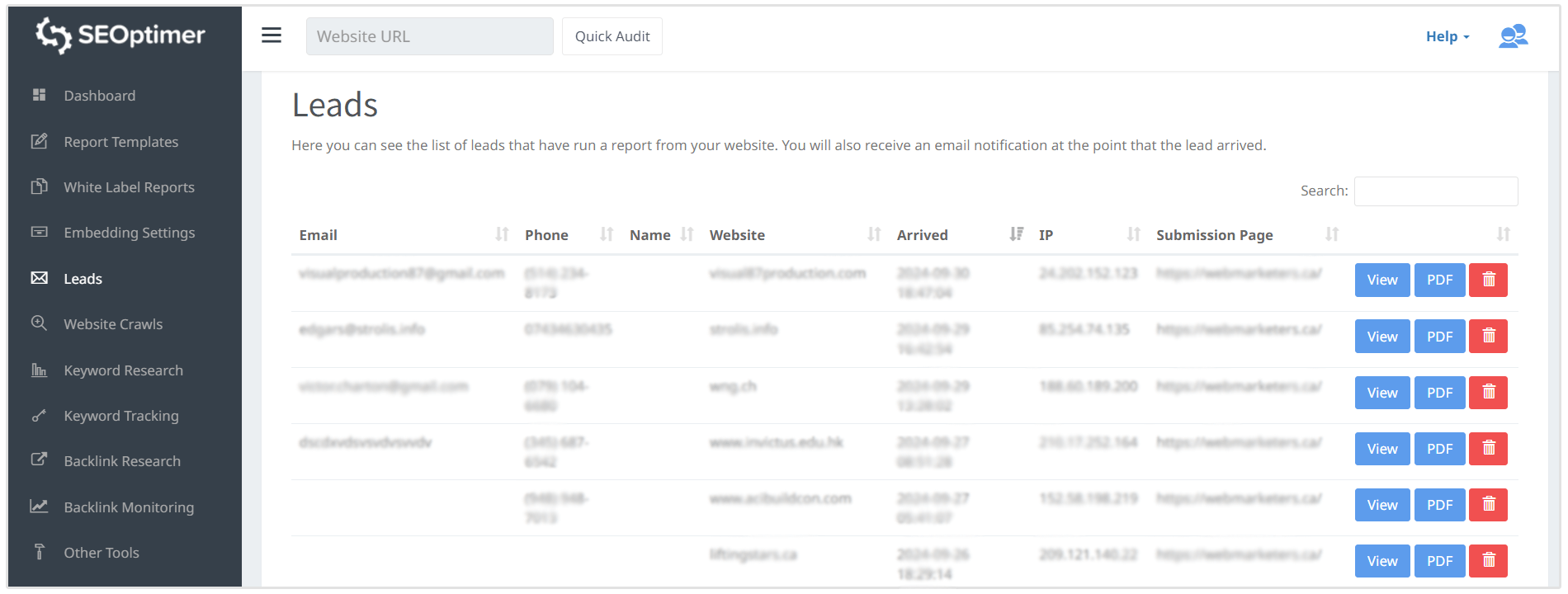
Offer Free Tools and Resources
Another great tactic to provide value and generate SEO leads is by creating free tools and resources on your website.
And when I mean resources, I don’t mean blog content.
These tools can attract visitors to your website, engage them with your expertise, and convert them into potential leads.
Here are some ideas of the free tool and resources I’m talking about:
SEOptimer Embed Tool
As I mentioned, SEOptimer offers an embeddable SEO audit tool that you can integrate directly into your website.
Visitors can input their website URL and receive a free, automated SEO report detailing site performance, keyword rankings, and technical issues. This not only engages visitors but also captures their contact information, making it a powerful lead-generation tool.
Oun Art from LinkEmpire says that offering free SEO audits helps bring prospects into their link-building agency.
For example, 70% of users who download our free SEO audit report sign up for a consultation within 30 days.
- Oun Art, Founder & Chief Link Strategist at LinkEmpire
Keyword Research Cheat Sheet
Create a downloadable cheat sheet outlining basic steps, tools, and best practices for keyword research for businesses in your niche.
For instance, if your agency targets landscaping businesses in New Orleans, then you could create a detailed cheat sheet on how to find keyword ideas.
You can include templates for mapping keywords to content and optimizing pages. This resource can serve as a lead magnet when visitors exchange their contact details for access.
Free Tools to Add to Your Website
Here are other free tools you can create or integrate into your website to attract SEO leads:
- Site Speed Checker: Allow visitors to check their website's load time and get recommendations to improve it.
- Backlink Checker: Provide a basic report of backlinks pointing to a visitor’s site, with suggestions for increasing quality links.
- On-Page SEO Checklist: Interactive tools where users can check off tasks they’ve completed for better on-page optimization.
- Content Idea Generator: Help users brainstorm topics based on their niche keywords.
- Competitor Analysis Tool: Offer a mini-report showing key metrics like estimated traffic and top keywords for a competitor.
Other than these three ideas, you could also create a mini course teaching the basics of SEO.
Reach Out to Poorly Optimized Websites Online
Let’s imagine that most of the clients you serve are in the healthcare industry, and you’re looking to get more SEO clients in this specific market.
You can simply do a Google search, and navigate to the 10th page or so.
Now, take a look at all the websites listed on this page; you’ll probably find that most of them are either poorly designed or poorly optimized, which means that they could benefit from your agency’s services.
From here, it’s simply a matter of getting in touch with the relevant companies, and pitching your agency’s services to them.
If you can identify a few things that they can do to improve their website in your email to them, this will make for a pretty convincing pitch.
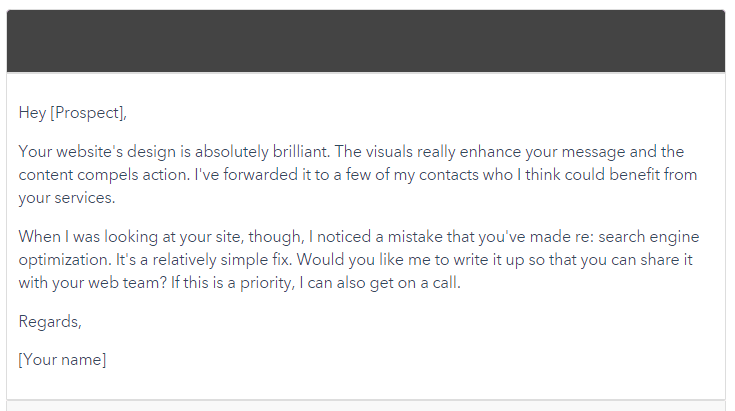
Note: we will share some tips on how you can contact SEO leads at the end of this blog post or you can directly skip to that part.
Attending Web and SEO-Related Meetups
Attending relevant meetups is a tried-and-tested technique that many agencies fall back on. Get to chatting with the folks at these events, and see if they’re in need of any SEO services.
Now, be sure to tailor your pitch to each person you meet here. If a particular attendee is working with a tight deadline and wants to confirm their SEO vendor ASAP, then there’s no harm in telling them more about your agency.
But if you’re speaking to someone who’s still learning about how SEO works, then pitching to them right off the bat is likely to turn them off.
So, what’s the best way to reach out to leads who aren’t ready to buy?
Simple — offer to send them a white-labeled SEO report of their website with recommendations on how they can improve their search rankings. To do this, you'll need to ask for their email address.
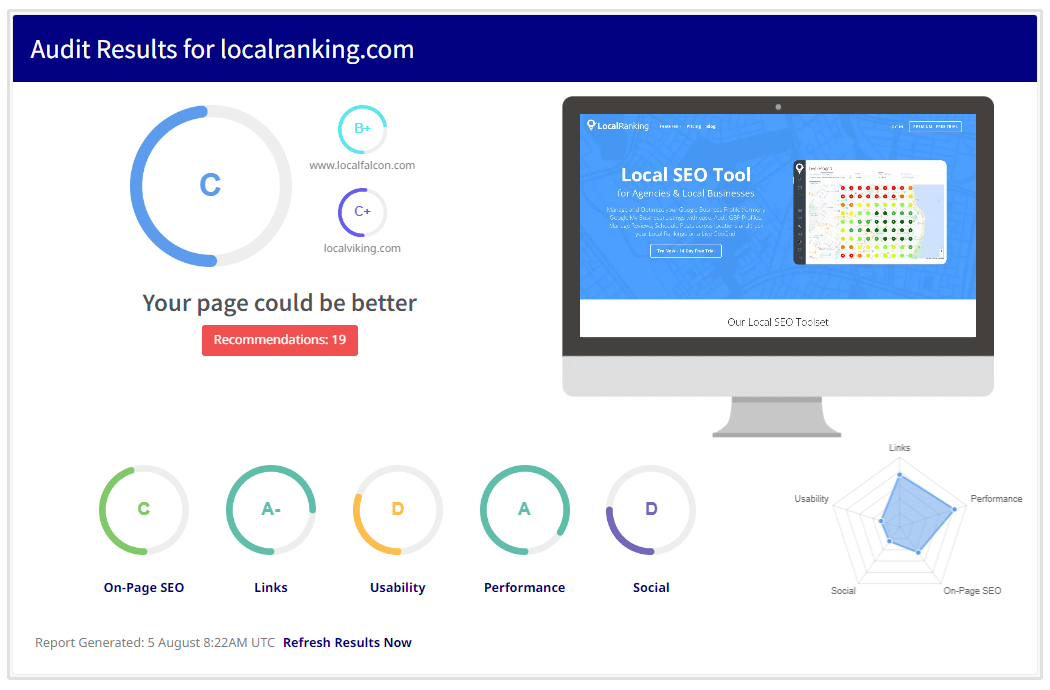
From there, it’s a matter of staying in touch and adding value to your lead, so that you’re the first person that they think of when they’re ready to buy.
Use Job Sites to Find Opportunities
Companies often use job sites and LinkedIn to find and hire SEO professionals.

You can use this as an opportunity to pitch your SEO services to these companies and explain the benefits of hiring an agency compared to hiring a full-time employee.
If a company is actively advertising an open position in their SEO department it means that they are willing to pay someone for a long period to help them with search engine optimization.
This immediately qualifies a business as a good SEO lead.
At my agency, one of our go-to tactics is utilizing Craigslist, and other locally-focused platforms to source leads. Specifically, we seek job listings or RFPs from businesses looking for digital marketing services and pitch DAVID.MARKET as a better option than hiring in-house.
Our selling points include being a dedicated team of marketing experts that can hit the ground running, the breadth of our skills, and potential cost savings related to not needing to offer the usual employee benefits.
- Andrew Clark, Former Director of Organic Growth Marketing at DAVID.MARKET
Get Listed in Digital Agency Directories
One of the ways that an agency can get more SEO leads is by getting listed in relevant agency directories.
This includes sites such as Digital Agency Network, Clutch, Top Digital Agency, etc.
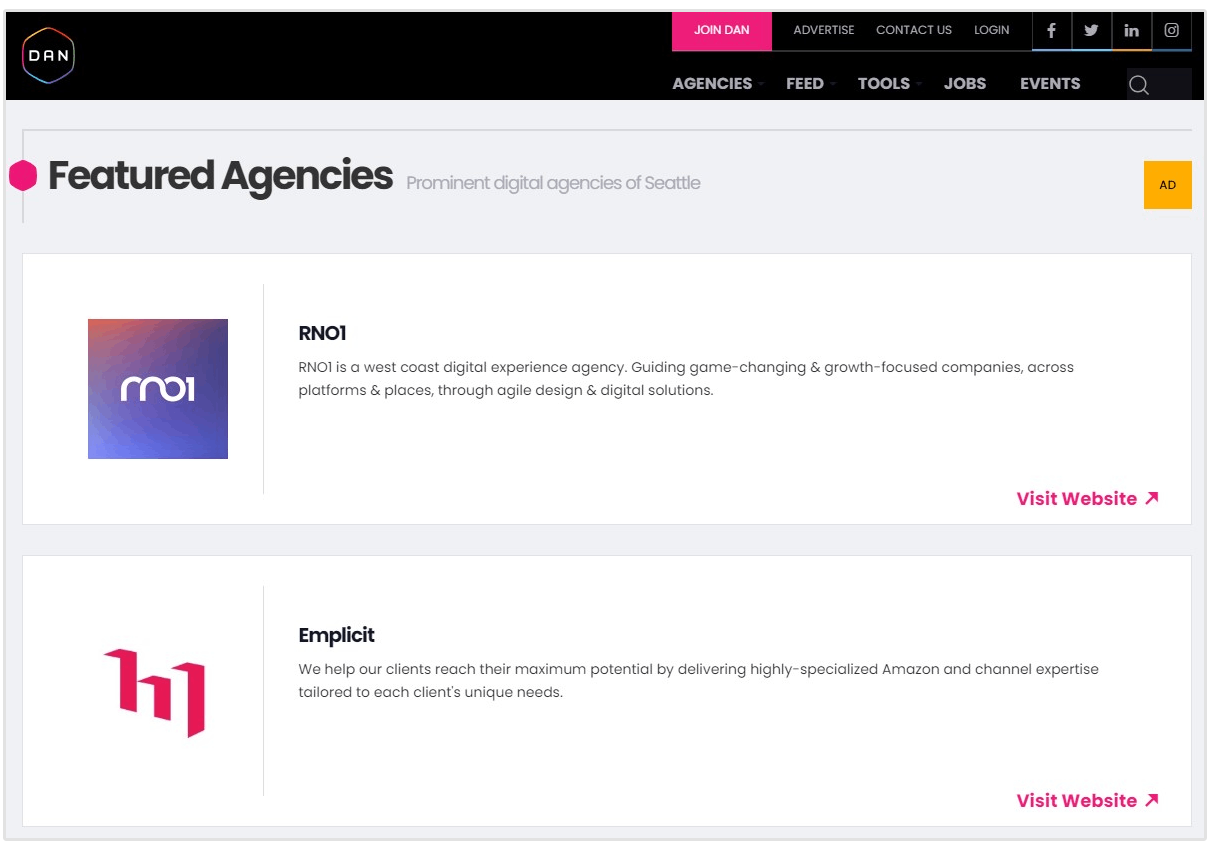
Getting listed in digital agency directories is free (in most cases) and the users who visit these directories are very motivated to find a marketing partner to help them with their needs.
Because of the higher level of motivation, these leads are easier to close and convert.
Our most valuable SEO traffic sources are our directory listings on Clutch and DesignRush and our Google Business Profile.
- Peter Heise, President of Correct Digital
Not only should you create a profile on these agency directory sites, but you can also use websites like Craigslist, Yelp, and Yellow Pages to increase your agency’s online reach and visibility.
Creating Educational Blog Content to Attract Leads
We also recommend that you invest time and energy into creating blog content to attract SEO leads.
While some of the outbound lead generation tactics may be unsustainable in the long run, inbound marketing is one of those things that can continuously drive results.
For instance, if you produce high-quality educational content, this could bring you traffic and leads for months and even years down the road.
Jesse Ringer, founder and CEO at Method and Metric SEO Agency, shares that this is their most effective method for generating leads and getting SEO clients.
Our most effective method for generating leads has been free and low-cost educational content -- workshops, webinars, and digital guides have been the main drivers for us. In 2024, 40% of our clients and 78% of our revenue came from some form of educational experience.
- Jesse Ringer, Founder and CEO at Method and Metric SEO Agency
So, how will creating blog posts help you get SEO leads?
Well, if you’re able to create blog articles that successfully rank for relevant keywords, then you’ll be able to generate targeted traffic to your website.
Think about content ideas that will solve some of the problems that your ideal buyers may be experiencing in their businesses.
Here’s a useful example of this. TheDentalSEOExperts, an SEO agency for dentists, regularly publish useful blog content on their website.
The content aims to assist dentists with growing their practices’ online presence.

Creating an Authoritative SEO Group or Community
The next strategy to get SEO leads is to create your own SEO group/community. This can be in the form of a Facebook group or email newsletter.
Creating an authoritative group will take time so don’t expect new SEO leads to come in from day one.
The idea behind this is to create a group that business owners can join. The group should be an active space where business owners can find SEO news, actionable tips, and strategies to grow their businesses.
For instance, check this Local SEO focused Facebook group by Tim Kahlert.
As you can see there are about 50k members in this group consisting of business owners and marketers. I’m pretty sure Tim has been able to get a few SEO leads from this group.
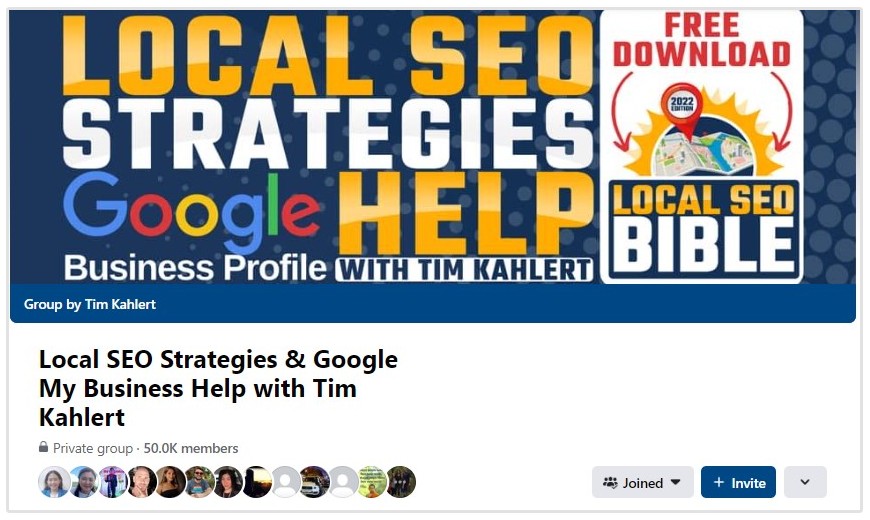
If you own the group, you can also promote your blog posts in this group and feature guests from other niches such as social media management, customer support, etc.
Use the Hottest Social Channels
Even though your agency focuses on providing SEO services to businesses, you should still have a presence on social media platforms.
More specifically, you want to use the hottest (trending) social platforms to drive awareness for your brand.
At the time of writing, TikTok is that channel.
Brands and businesses are getting insane reach on TikTok at the moment. Nathaniel Miller from The SEO Marketing Dad is using TikTok to generate leads and get more SEO clients for his agency.
Honestly, TikTok has been a game-changer for me. It might sound unconventional for an SEO agency, but TikTok is where I'm seeing massive traction.
In the last 60 days alone, my TikTok content has driven:
23K views
326 profile views
11 comments
49 shares
5 inbound leads
3 converted customers
91 new followers
Nathaniel provided us with some insights on which content works best for his SEO agency on TikTok
The key is making short, actionable content that demystifies SEO. I focus on sharing easy-to-understand SEO tips that small business owners can implement right away.
The engagement and reach I get from TikTok is unmatched—people want quick, no-BS advice, and that’s exactly what I give them.
It’s not just about views; it’s about getting people to take action, and TikTok’s been amazing in driving that kind of engagement.
Host an SEO Webinar
Hosting a webinar offers you a great opportunity to showcase your knowledge of the SEO industry. Not only that, you can show attendees case studies of previous customers who you were able to help.
Now you don’t only need to cover SEO topics in your webinars. Think of your target audience and what pain points they may be experiencing in their businesses, and try to create a webinar that aims to solve this pain point.
For example, if your ideal buyer is a startup that’s still raising cash, you could host a webinar on financial management for startups featuring a guest that has experience with this topic.
Creating a PPC Campaign to Serve Ads to a Specific Audience
Another type of inbound marketing that you can use to get SEO leads is by creating a Pay-Per-Click (PPC) campaign targeting your ideal audience.
With this form of marketing, you’re able to set up ads that target users in your ideal location, searching for your target keywords.
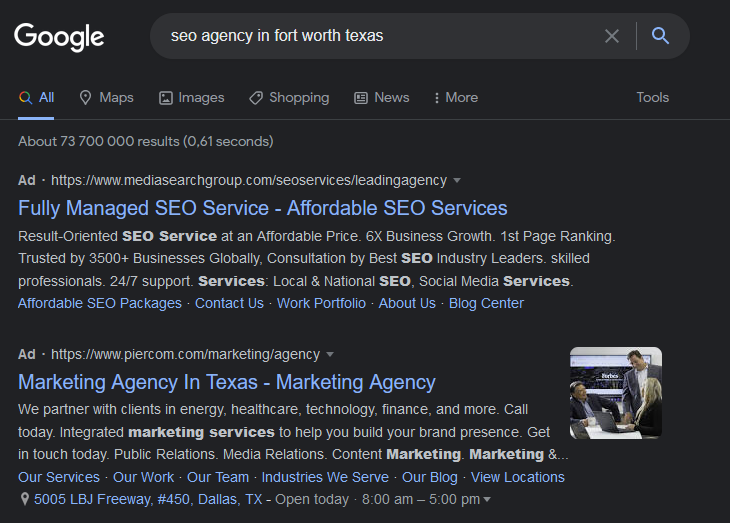
PPC campaigns can yield immediate results when implemented properly, but they can also cost a fortune if you don’t know how to set up the right targeting, bid strategies, and keyword matching.
If you know how CPC marketing works and you’re able to target the right people at a cost-effective rate, then this can be very effective to generate SEO leads every month.
Paul DeMott, Chief Technology Officer at Helium SEO told us that they use Google Ads as part of their lead generation strategy.

According to Paul, this is their most effective method of generating and converting leads into customers.
To add, our company utilizes Google Ads strategically with hyper-targeted keywords. Let me give you a clear example wherein we bid on long-tail search terms like “SEO for ecommerce businesses” or “local SEO for home services.”
This approach allows us to capture high-intent traffic from prospects who are actively searching for solutions. This strategy has proven to be the most effective in generating and converting SEO leads into long-term clients.
- Paul DeMott, Chief Technology Officer at Helium SEO
Create a Podcast
Like webinars, podcasts offer SEO agency founders and managers the opportunity to discuss various topics related to SEO and business. Podcasts can be hosted more frequently than webinars since they are easier to produce.
For example, NerdBrand is a digital agency that hosts a podcast on all things marketing featuring guests with unique insights on various discussion points.
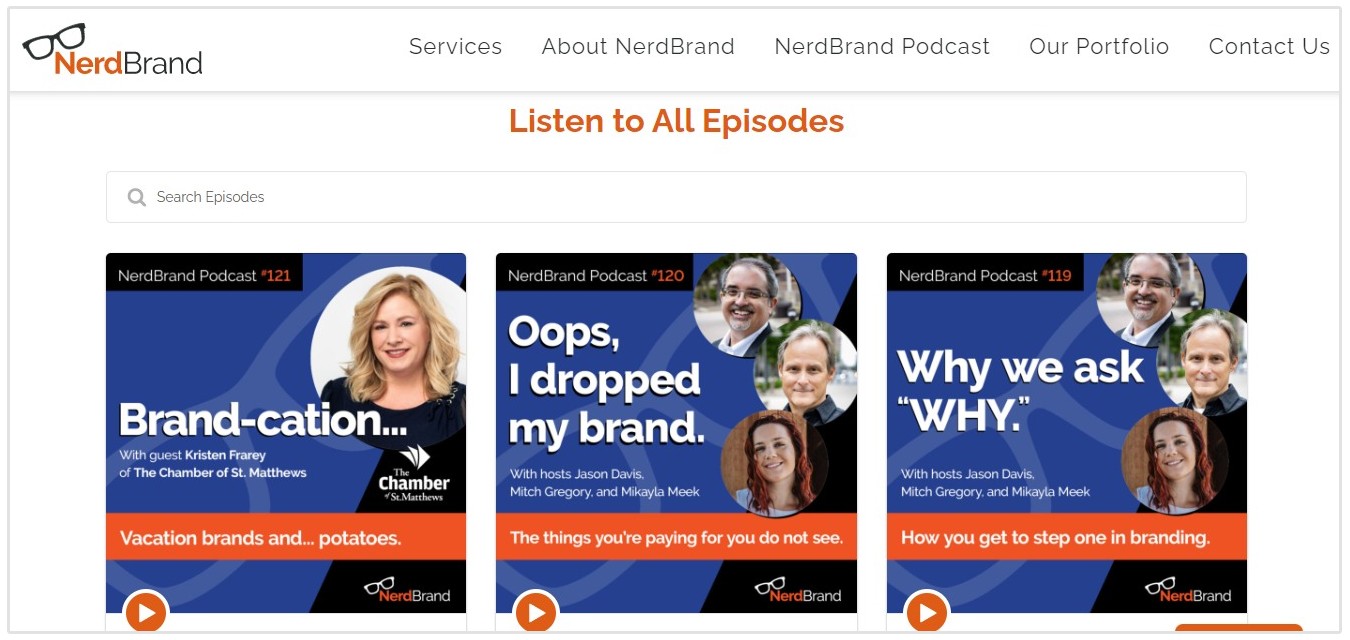
Write SEO Focused Guest Posts
Writing guest posts is an excellent way to generate SEO leads, but it requires some planning to do effectively.
You should start by identifying high-quality websites within your local community or that your ideal buyer is reading, these sites should have an engaged audience and a strong domain authority.
For instance, if you provide SEO services to dentists and dental clinics, you could target blogs and websites about the latest news in dentistry.
It’s also important that you filter out the lower quality sites and only target the more “premium” domains with a strong link profile.
You can use SEOptimer’s Backlink Research tool to find any site’s Domain Strength. I’d say nothing less than a Domain Strength score of 40.
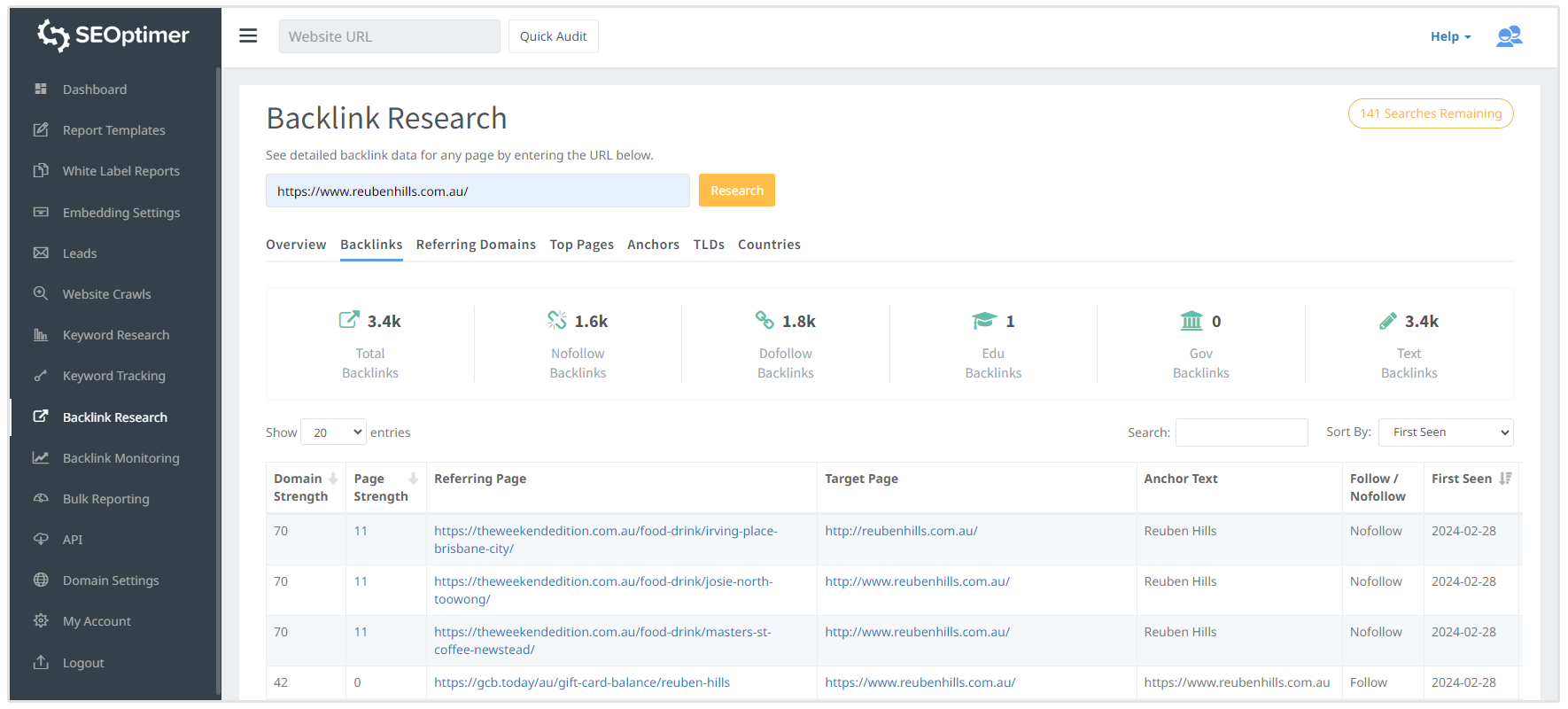
Remember, the higher the Domain Strength and backlink profile, the more link equity gets passed to you.
Once you've shortlisted potential sites, study their existing content to understand their audience's needs and identify gaps.
Then, you need to pitch topic ideas that provide value and showcase your SEO expertise, examples of good topics could be "5 SEO Mistakes That Are Costing Your Website Traffic" or "How to Rank Locally: SEO Tips for Dentists."
When writing your guest post, focus on creating high-quality, actionable content.
Share practical tips, real-life examples, and case studies to establish your credibility as an SEO service provider.
Get Referrals from Existing Clients
The truth is getting referrals from existing clients is one of the best ways to generate SEO leads and get clients.
Referrals carry a high level of trust since they come from satisfied clients who vouch for your expertise.
We generate leads through our business via relationships.
Agencies are all about people and not the ones you hire, but the ones you build complementary businesses who can pass referrals to each other.
- Anthony Barone, SEO Consultant, Co-founder and Managing Director of StudioHawk
Studies show that referral marketing can drive up to 65% of new business for agencies, and referred clients have a 37% higher retention rate compared to those acquired through other methods.
To leverage this, you can establish a formal referral program that incentivizes clients to recommend your services.
For example, offer discounts, account credits, or free additional services for each successful referral.
Sam Browne from HARO SEO says that they use discounts to motivate existing clients to give referrals at their agency.
We provide clients with a discount if they suggest our services to their personal connections. It's imperative to note that you must simplify it for clients to easily market your company.
- Sam Browne, Founder at HARO SEO
You want to make it as easy as possible for clients to refer you by providing them with templates or shareable links they can pass on to their network.
The other thing is, this tactic will only work if you can deliver real, measurable results to existing clients.
In fact, I think it’s safe to say that if you can show your existing clients results, then they are likely going to put in a good word with their personal network, without you even asking them to do so.
Create Case Studies and Portfolio Pages
Social proof is yet another great way to get leads to buy. More specifically, you should try and create case studies from existing clients on how you’ve been able to deliver great results.
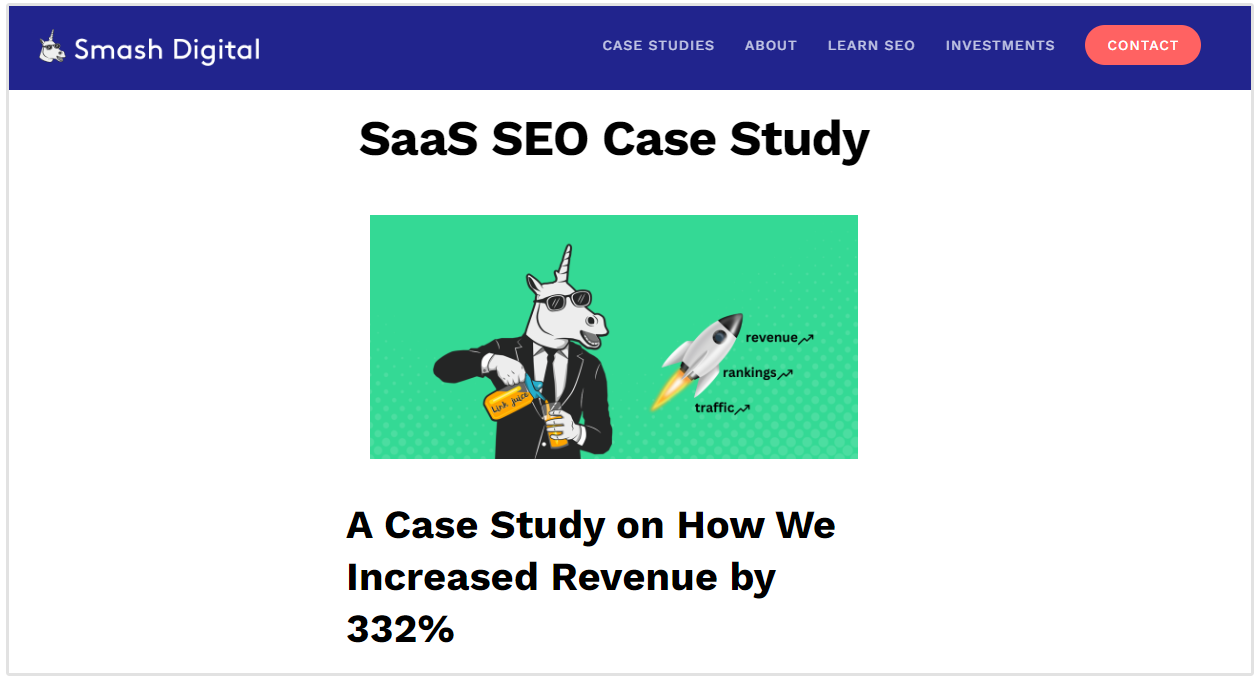
For instance, the above screenshot from Smash Digital on how they were able to increase a client’s review by 332% is a great example of how to create an effective case study for your agency.
Filip Dimitrijevski from ClickVision, an agency based in Sweden says that case studies have been effective for bringing in new SEO clients.
Case studies and success stories from real clients have always been the most important tools we've used. They got a report from us about how we helped a SaaS company get 200% more web traffic in six months. Two new buyers got in touch with us in less than a week.
- Filip Dimitrijevski, Business Development Manager at ClickVision BPO
Use Direct Mail to Get More SEO Clients
You don’t need to rely on purely digital channels to generate leads and get SEO clients.
In fact, since digital channels are sometimes overcrowded, traditional channels like direct mail aren't as competitive.
One agency that has seen great success with direct mail is Marketing Essentials.
Our agency has seen great success with what might seem like an old-school technique: direct mail campaigns.
Why do I think this has worked so well lately? There are a few reasons. First, we’re sending to a narrowly targeted list - not a purchased one. We’ve already done research on the prospects we want to send to, so we’re confident they’re in our target audience.
Two, we tailor the messaging and design specifically to their needs. And three, we create a seamless user experience with QR codes and tracking links. It’s a highly-targeted, tangible piece that helps prospects learn more while we can monitor engagement and make improvements for the next send.
We’ve found that email inboxes are often full, but physical mailboxes are empty. The bottom line, it’s not always about chasing the newest social platform or tool. It’s about being aware of the market and your customers enough to offer what they need, when they need it.
- Grant Covault, Former Chief Business Development Officer at Marketing Essentials
Purchasing SEO Leads from a Database
If you’re really struggling to get SEO leads for your agency, you can always fall back on purchasing leads from a database, although this is probably the last option you should explore.
Now, we know that most agencies prefer to generate their own leads rather than purchasing leads. When purchasing leads, check the following:
- Purchase leads from a reputable vendor, and
- Purchase selectively (ie: only buy leads that are a good fit for you, instead of buying 1,000 email addresses and spamming them with cold emails).
First and foremost, make sure you’re buying your leads from a reputable vendor that guarantees a certain level of accuracy.
For instance, LeadCandy guarantees that no more than 5% of the verified emails they charge their customers for will bounce, and should a customer’s bounce rate exceed 5%, they’ll gladly refund the credits charged for those emails.
Another tool we like is UpLead, which verifies its leads’ email addresses on the spot, before releasing the information to its customers
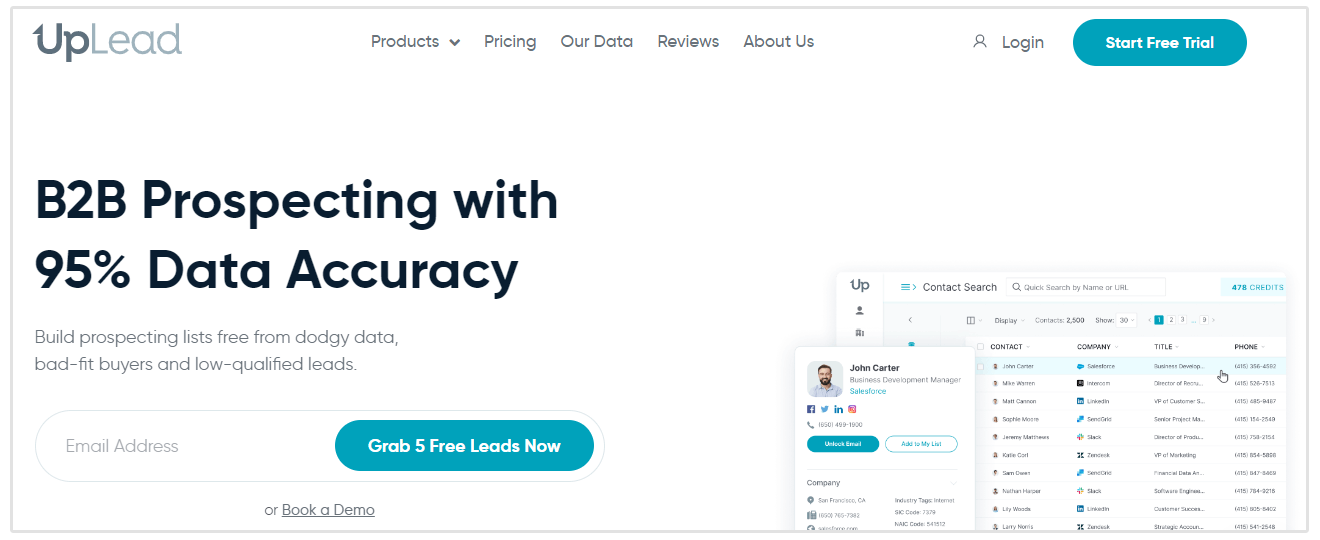
On top of purchasing your leads from a reputable vendor, it’s also important to purchase selectively. Bearing this in mind, choose a vendor that allows you to filter their database using various criteria, so that you can hone in on the specific leads who are most likely to convert.
For example, UpLead allows its users to filter its database of over 30 million contacts using 50 different criteria, including business industry, location, number of employees, sales revenue, etc.
This makes it easy for you to build highly-targeted lists, and reach out to leads who are a good fit with your company.
Tips for Generating SEO Leads with Blog Posts
Blogging can be exceptionally effective in driving leads — but that’s assuming that you put the time and energy into producing high-quality, valuable content.
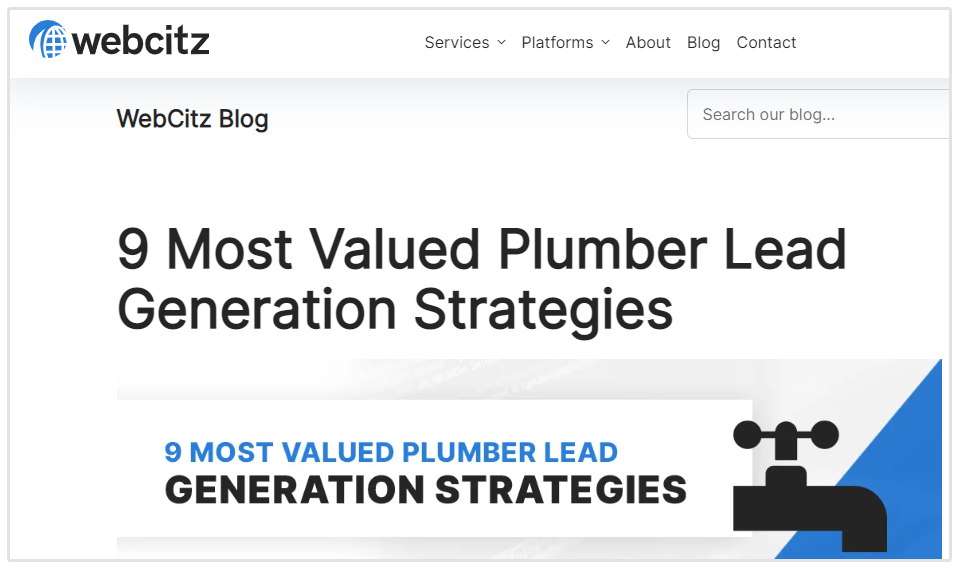
Want to maximize the leads that you generate from your blogging and content marketing strategy? Here are some tips to keep in mind:
1. Add a Call To Action at the End of Every Post
Since you’re looking to generate SEO leads from your blog posts, be sure to add a relevant CTA at the end of each post. CTAs you might use include:
- Sign up for our newsletter
- Sign up for an SEO site audit
- Sign up for an SEO consultation
- Request for a non-obligatory quote
The more specific you are with your CTA, the more effective it’ll be. For instance, instead of simply saying “Sign up for an SEO consultation”, you might say:
- Sign up for a free SEO consultation worth $299
- Sign up for a free 60-minute SEO consultation
Remember, it’s all about the context.
2. Offer PDF Downloads for “Ultimate Guide” Articles
We all know that long-form content is more engaging and shareable than shorter and more generic articles.
In fact, here’s an A/B test by Neil Patel that illustrates exactly how much more effective long-form content is in generating social shares:

The solution is obvious, stop writing 500-word articles that are generic, fluffy, and don’t add value to your readers in any way, and start producing more “Ultimate Guide” type articles that are rigorous and substantial.
Now, other than adding your standard CTA to your articles, here’s another genius way that you can use these articles to generate leads: offer a free PDF download of the article, and capture your readers’ email addresses in the process.
For instance, check out UpLead’s Growth Handbook, which outlines 230+ Customer Acquisition Tactics:
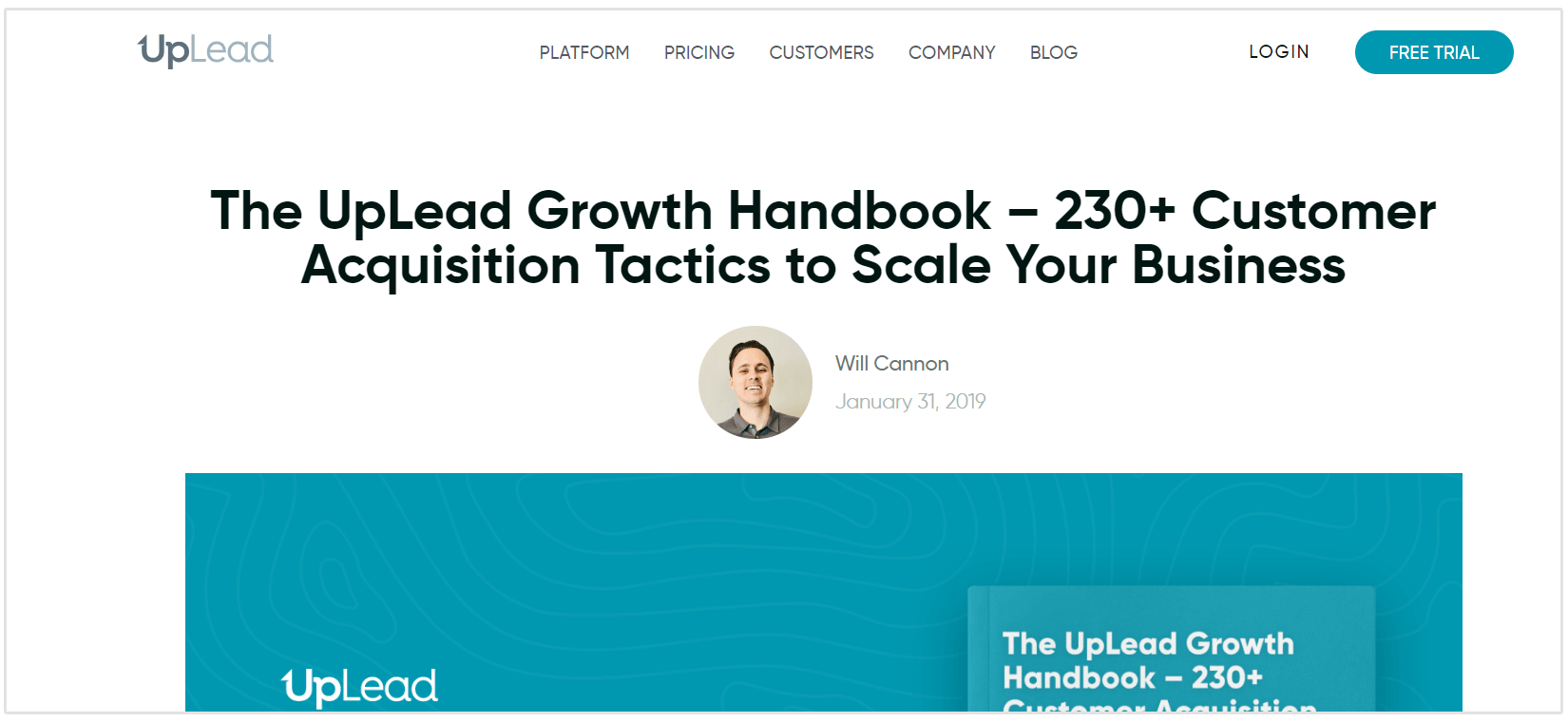
At the start of the blog article, UpLead embeds a form that allows readers to input their email addresses in order to receive a free PDF of their Growth Handbook.
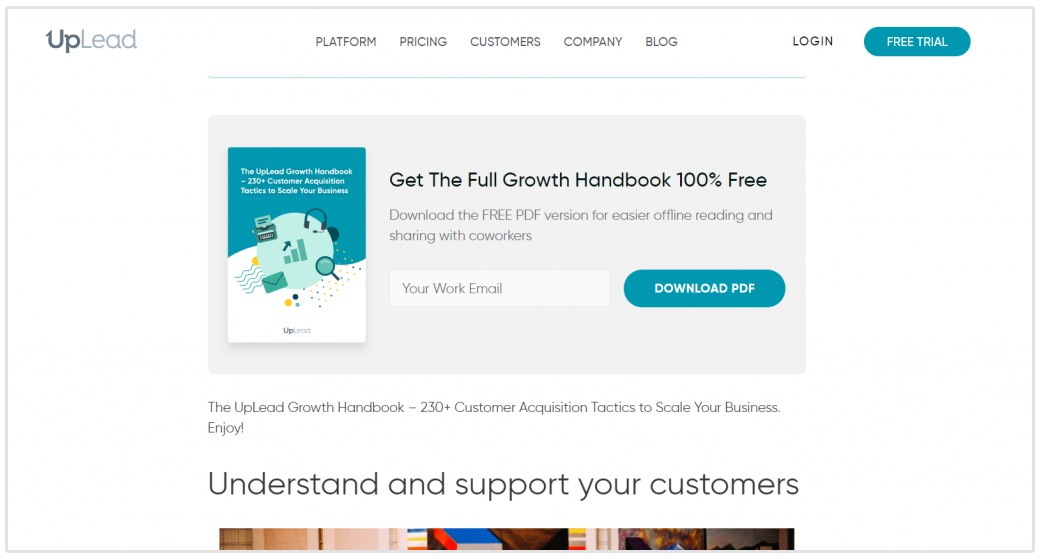
It isn’t easy to get through 230+ tips or tactics in a single sitting, so we’re betting that they drove a ton of sign-ups (and leads) using this form!
3. Focus on Quality and Quantity
As we’ve just discussed, we know it’s important to produce high-quality, valuable content. But this doesn’t mean that you can focus on quality at the expense of quantity — both these things have to go hand in hand.
In other words: if you don’t post regularly and consistently, it’ll be tough for you to generate a significant number of leads from your blog (and that’s even if you produce some of the most amazing content that the world has ever seen).
So, how often should you be blogging? The answer is, as much as possible.
According to HubSpot, companies that publish 16+ blog posts per month get a lot more leads than those that publish 0 to 4 monthly posts.
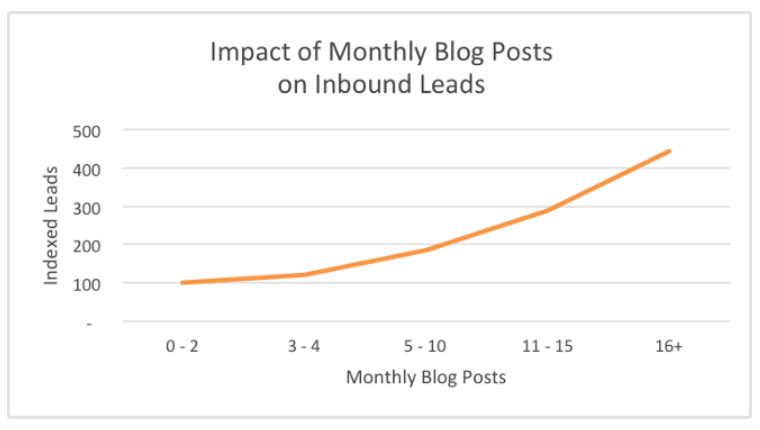
How to Research and Qualify SEO Leads
As you improve upon your lead generation, you’ll have a long list of SEO leads to whom you can reach out to. But before you reach out to them, you’ll want to take some time to research and qualify them.
More specifically, you should conduct research on the following aspects:
- Company structure and key decision-makers
- Their digital presence, more specifically their current search engine performance
First and foremost, read up on the company, and try and find out who the decision-makers are.
Apart from learning more about the company and how it’s structured, you should also take a look at its digital presence across the web. For instance:
- Look at their website to see if it’s updated. Are there any design or UX problems with the site? Are there any SEO problems? Is the site mobile-friendly?
- Look at their off-page SEO such as keyword rankings and backlinks, and benchmark them against their competitors to see if there’s room for improvement.
- Look at their social channels and assess their social strategy. Are they posting regularly? Is their tone consistent? Do they have a decent following and engagement level? Are they replying to the comments that they get on their posts?
The goal is to have a solid understanding of their situation and the current challenges that they’re facing so that you’re well-equipped to provide them with valuable insights when you speak to them.
Why Qualify SEO Leads?
Qualifying your SEO leads is all about working smart. If you make the effort to identify and sift out high-quality leads right off the bat, this means that you’ll waste less time talking to people who won’t convert further down the road.
Now, take a second to think about what sort of SEO clients can afford to pay for your agency’s services, and are willing to do so.
Ideally, you’ll want to get in touch with clients who:
- Are in an industry with a decent profit margin
- Aren’t a solo entrepreneur
- Are working in an established company that’s been around for a few years
To go one step further in assessing whether a potential client is a good fit, use tools such as Spyfu to identify if their company is spending on PPC.
If they are, this is a good indication the company has a sizeable marketing budget, and that they understand the importance of marketing.
How to Contact SEO Leads and Convert Them Into SEO Clients
Once you’re done researching your SEO leads and their company, the next step is to reach out to them.
In this section, we’ll walk you through the best practices for emailing and getting in touch with your leads.
1. Keep your Subject Line Casual
Most marketers and sales reps employ formal language when writing sales emails — so an easy way of standing out is to keep your tone casual.
For instance, instead of using a subject line such as: “Want to improve your SEO and rank on page one of Google?”
You could do something along the lines of:
- I’m going to help you get on page one of Google (for real)
- If you want to rank on Google, here’s what you should do
- I just Googled you, and here’s what I found…
As a general rule of thumb, the more your subject line sounds like it was written spontaneously and by an actual human, the higher your open rate will be.
If possible, try and incorporate urgency and curiosity in your subject lines, and personalize your subject lines as well.
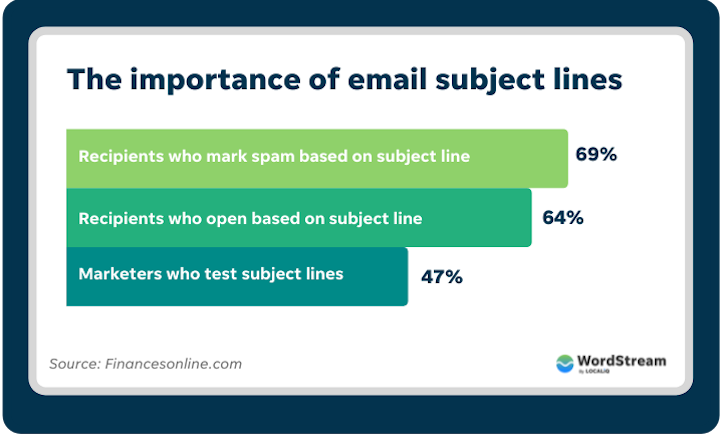
Image source: WordStream
2. Offer Value Upfront
Offering value upfront in cold outreach is a great strategy to generate SEO leads and establish credibility for your agency.
By providing immediate benefits, you demonstrate expertise and build trust, making prospects more likely to engage with your services.
Kyle Morris from LawTurbo says that cold emailing has been one of their most effective ways to generate SEO leads and convert prospects into clients.
The key is providing real value upfront. Instead of sending generic emails, we use personalized outreach to highlight specific issues or opportunities on a prospect’s site.
One tactic that’s worked especially well is creating quick Loom videos where we walk through their website, point out SEO gaps, and show how we can help. It’s a simple move, but it’s boosted our response rates by 20%.
- Kyle Morris, CEO and Founder at LawTurbo
Kyle’s advice is to keep the focus on the prospect. Don’t make it about selling, but make it about solving the lead’s main problem.
3. Make it Easy for Your Lead to Take the Next Step
If you’re hoping to land a face-to-face meeting with your lead, it’s important to frame your request in a way that makes things easy for your lead.
Here’s a bad example: I’d love to set up a meeting so that I can explain our SEO services to you in detail. Could you propose a couple of dates and times in which you’re available, and let me know what location works best for you?
And a good example: I’d love to explain our SEO services to you in person. Shall we meet at your office sometime this week? You can choose a date/time that suits you best using this link.
See the difference? The easier it is for your SEO clients to follow through, the higher your chances of converting your clients.
4. Keep your Email Short and Sweet
According to statistics, if you want to get a reply with your email, you should aim to have your email be between 50 to 125 words.
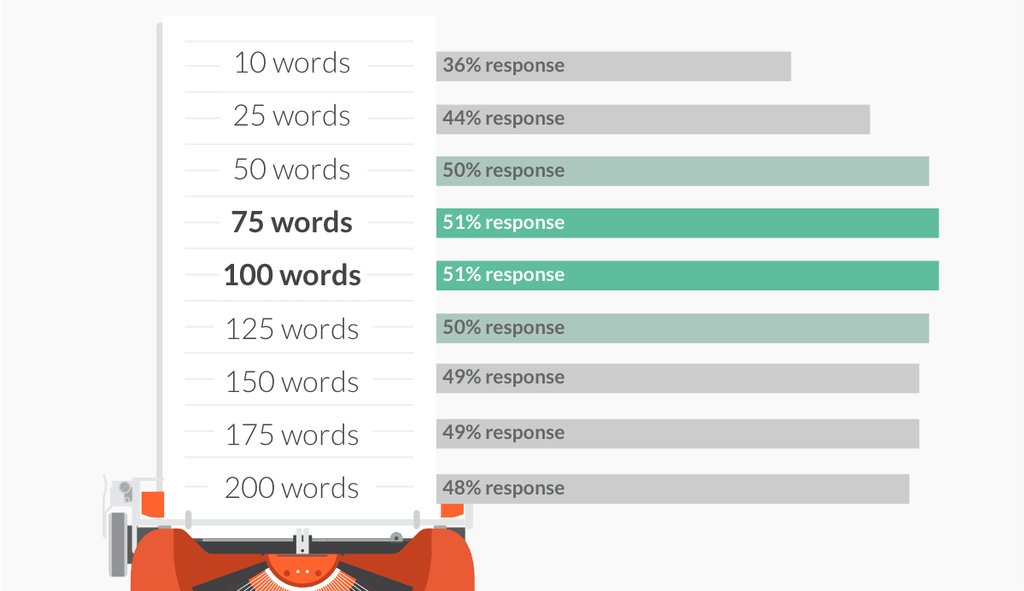
Remember, you’re not actually selling to your lead in the first email to them — so you don’t need to ramble on about the advantages of working with your agency.
You’re just trying to hook them and get them intrigued, so keep it short and sweet.
How to Follow Up with Your SEO Leads
Marketers and sales reps dislike doing follow-ups for a number of reasons.
Some folks find it difficult to remember to follow up. Others might be afraid of coming across as too pushy or aggressive, and yet others might mistakenly believe that follow-ups aren’t effective.
Well, here’s the thing, follow-up emails can actually get better response rates than your first email.
According to a study, first emails get a 30% response rate on average, fourth emails get a 13% response rate, and sixth emails get an impressive 27% response rate.
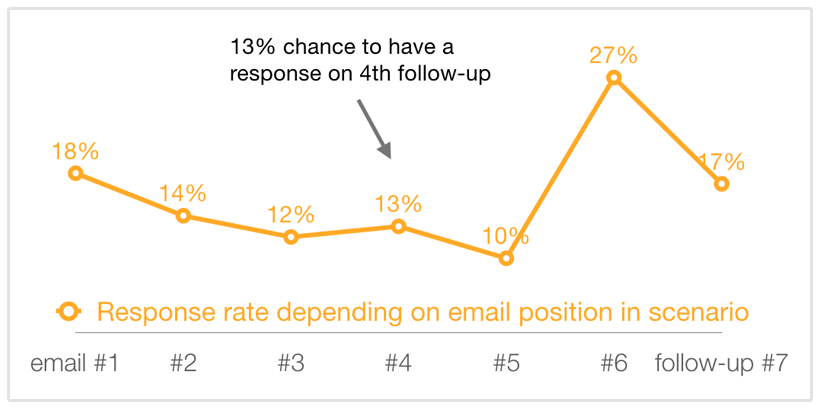
So, does that mean all sales reps should devote 2 hours per day to sending follow-ups to their SEO clients?
No, that’s not necessary. It’s fairly simple to automate your follow-up emails, even if you don’t have access to a fancy marketing automation platform or system.
To do this, simply use Mailshake or a similar tool that plugs directly into Gmail.
What not to Do When Pitching Your SEO Services to Leads
Make sure you steer clear of these mistakes when you’re pitching your agency’s services to new SEO leads.
1. Overpromise
We all know that there are a ton of factors that influence a company’s SEO ranking and that these factors are constantly changing. This makes it pretty much impossible for an SEO agency to guarantee rankings — regardless of how capable they are.
Bearing this in mind, don’t rashly promise your SEO leads that they’ll rank within a certain period of time, even if you’re confident that your company can achieve this for them.
You don’t want to overpromise and land your company or colleagues in hot water.
2. Wait Before Reaching Out
When’s the best time to reach out to your lead? Well, given that most leads do business with the company that contacts them first, the answer is: as soon as they enter your system.
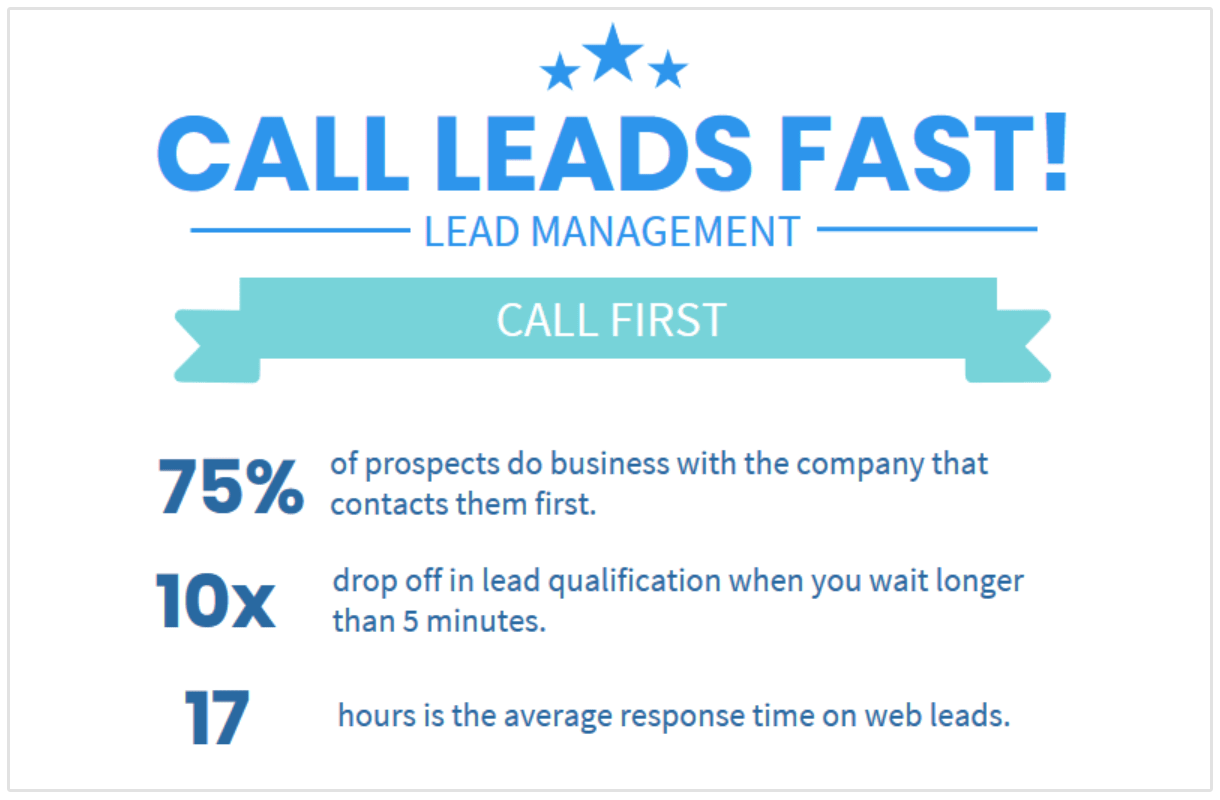
Image source: SpeedToContact
The above infographic says it all — if you want to have the best chances of doing business with your SEO leads, then be sure to contact them within 5 minutes of hearing from them.
3. Pander and Grovel
It’s important to be courteous and polite to your leads, but you don’t want to go to the extreme, and bend over backward to please them.
Why do we say so? Well, if you pander too much when communicating with your leads, they might take this to mean that you’re not confident in your agency’s services, or that you’re desperate for their business. Obviously, that’s a huge turn-off.
Outbound vs Inbound SEO Lead Generation: Which is Best for Getting SEO Clients?
Outbound lead generation is the process of finding SEO leads that don’t know anything about your business or who haven’t heard of your brand. Hence the name “outbound”, because you’ve got to go out and find these prospects.
Inbound lead generation refers to generating leads from prospects who discover your business by themselves instead of you reaching out to them.
Generally, inbound leads convert at a much higher rate than outbound leads. This is because inbound SEO leads are actively searching for agencies or freelancers to assist them. Whereas, with outbound leads, you’ve got to convince prospects that they need your services.
Tools for SEO Lead Generation
If you really want to scale your SEO lead generation efforts, then you can use different tools and products to assist you with the process.
SEOptimer
The first tool that you can use to get more SEO leads is SEOptimer’s Embeddable Audit Tool. This tool allows agency owners to generate more leads and sales from their websites by simply embedding a form on their websites.
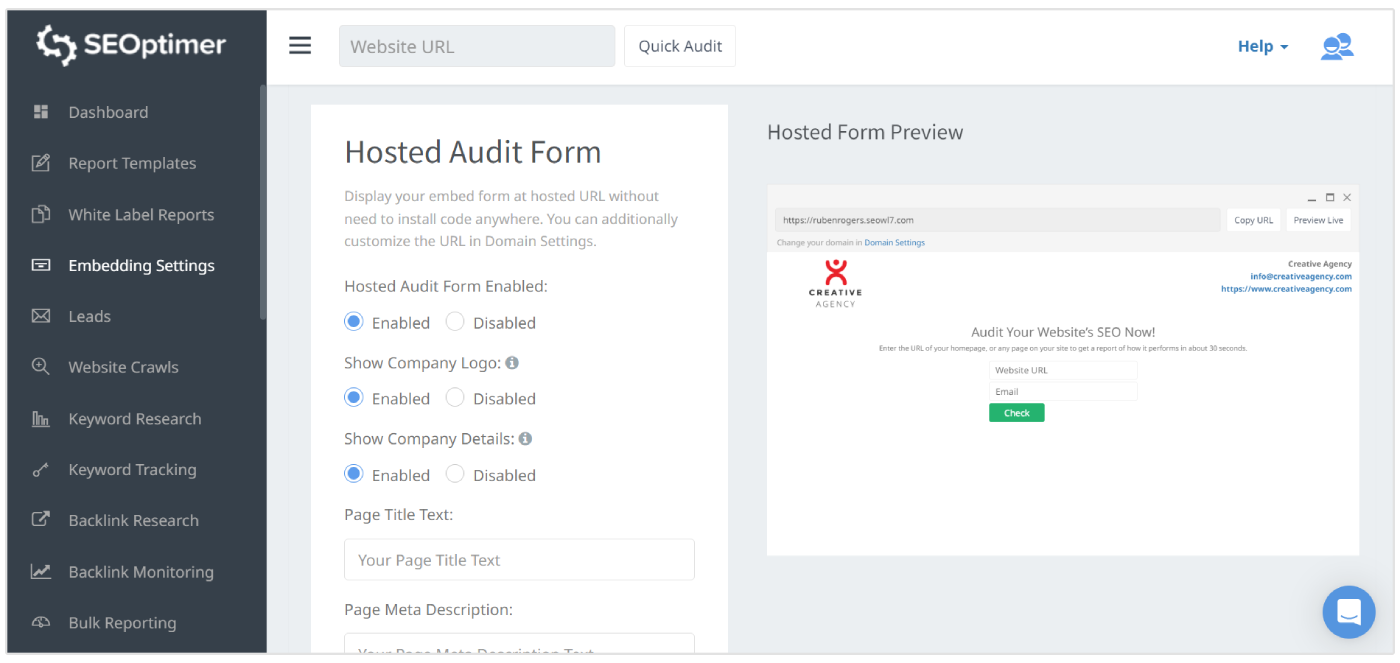
When someone adds the necessary information to all the form fields that you require, the tool will generate a custom report of their website’s SEO. These white-labeled reports can be completely customized according to your SEO agency’s branding and color scheme.
The tool will run on autopilot in the background without any involvement from you, and you’ll get new SEO leads delivered straight to your inbox whenever a report is generated.
Hubspot
Once you start scaling your SEO lead generation you’ll need a place to organize and manage all of your leads. Hubspot is a sales CRM that can help you track and manage all of your leads.
This lead management tool can help your sales team visually see where new leads are in the sales pipeline, set up workflow automation, create reporting dashboards, and more.
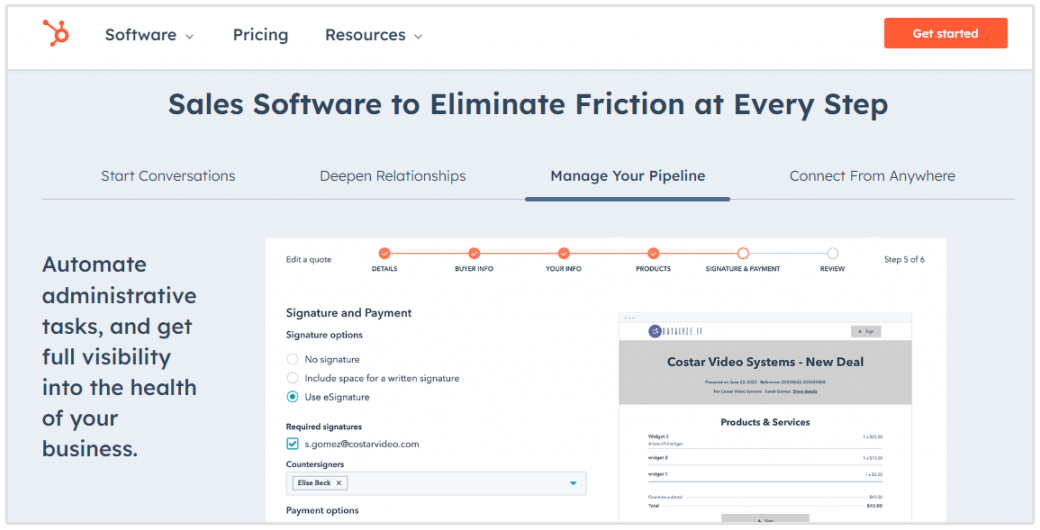
Intercom
Intercom is an on-site messaging service that enables you to engage with website visitors. Through Intercom, webmasters and agency owners can set up a chatbot that can help to funnel new website visitors to a lead generation form.
These chatbots can be completely customized according to your specific needs. For example, you can create a chatbot that asks visitors what services they might be interested in, and then redirect them to those service pages within the Intercom chat.
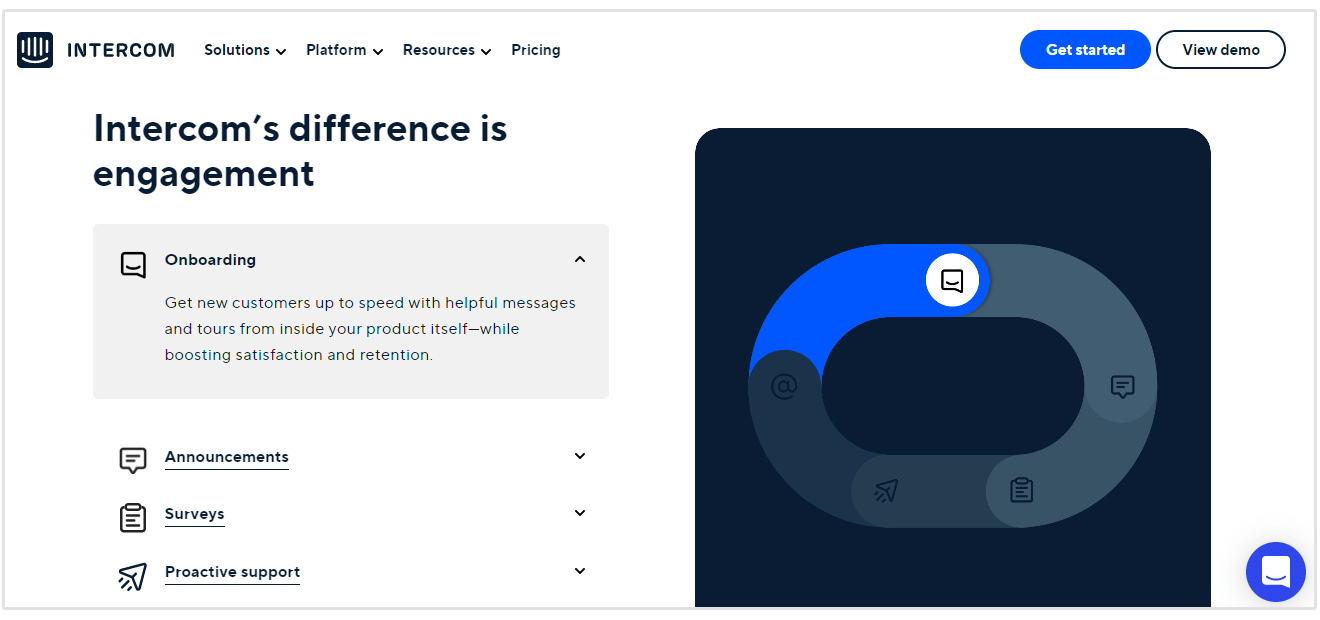
AdEspresso
If you’re running any paid marketing campaigns on Facebook, Instagram, or Google, then you need to constantly be monitoring campaign performance in order to get the best out of your marketing budget.
AdEspresso is an advertising tool that gives users the ability to create, manage, and analyze their advertising campaigns in one convenient dashboard.
This tool makes it easy to test multiple variations of an ad to determine which ones to pause or boost. AdEspresso also features a white-label report creator that creates reports of a client’s paid marketing campaigns.
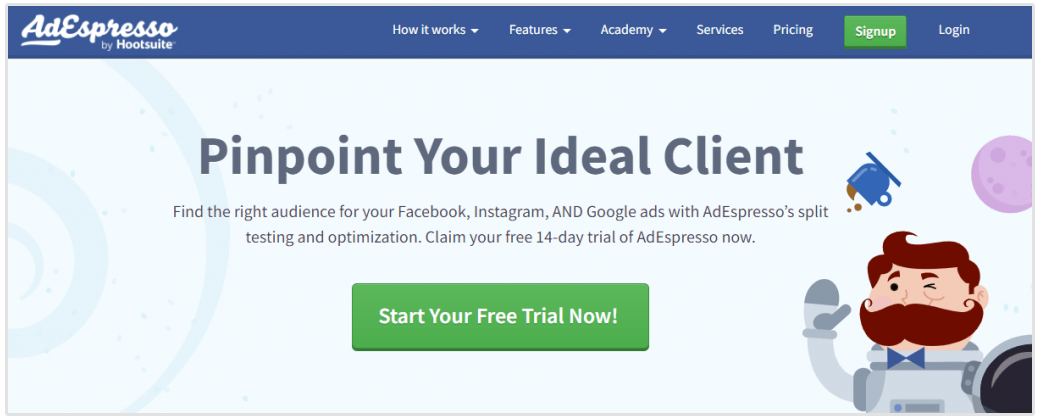
Conclusion
This concludes our guide on how to generate SEO leads and get SEO clients.
If you need some new ideas on SEO lead generation, follow the tips and suggestions that we shared to generate, qualify, and communicate with the leads you generate.
Remember, you might need to test out several methods before you find the one that works best for your agency.
I’d also suggest using more than one method so that you’re not too reliant on a single channel.










